When it comes to creating visually captivating indoor plant displays, color isn’t the only thing that matters. The texture of leaves—whether glossy, velvety, feathery, or leathery—plays a crucial role in adding depth, contrast, and character to your space. A well-balanced mix of leaf textures can elevate even the simplest collection of houseplants into a stunning natural masterpiece.
In this guide, we’ll explore how to combine different leaf textures for dynamic indoor arrangements, what plant types to use, and how to design displays that look both elegant and cohesive.
Understanding Leaf Texture and Its Impact
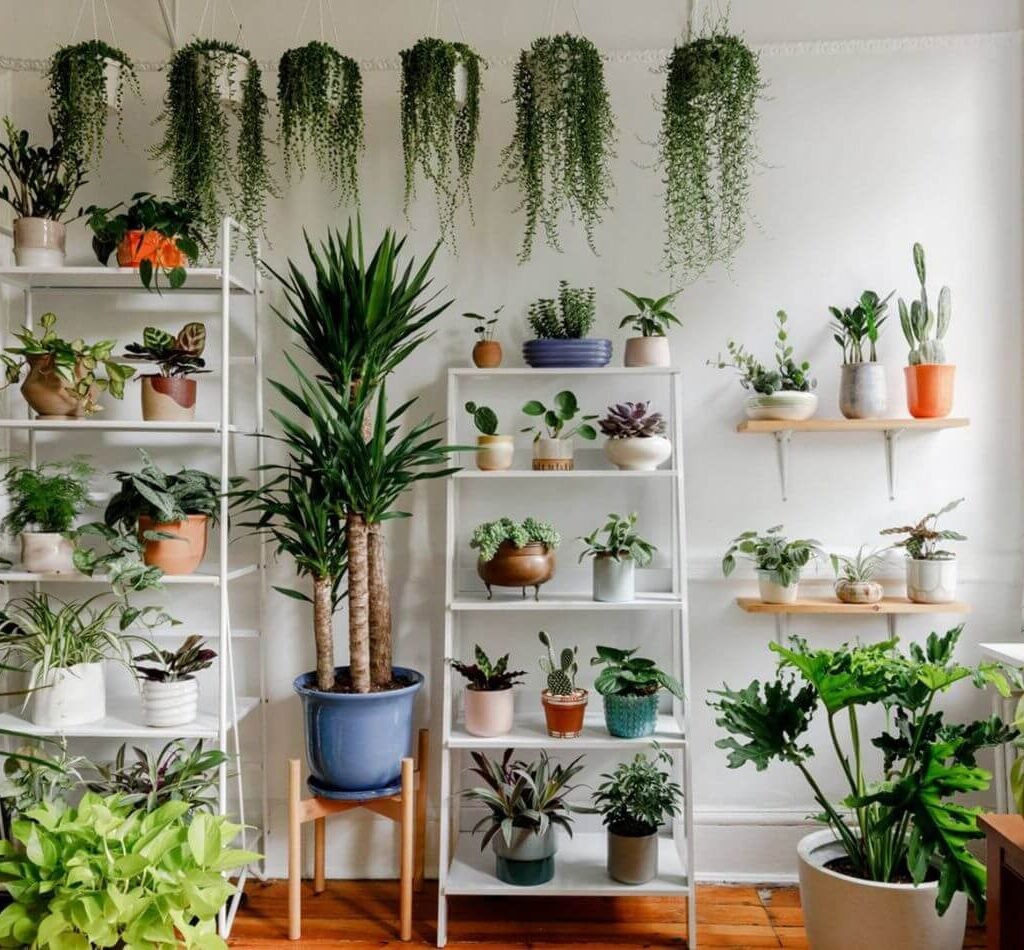
Leaf texture refers to how a leaf’s surface looks and feels. Some plants have shiny, smooth leaves that reflect light beautifully, while others boast rough, fuzzy, or patterned foliage that adds visual interest and tactile contrast.
Here’s how textures typically influence the visual effect:
- Smooth or Glossy Leaves – Reflect light and create a polished, clean aesthetic. Examples: Rubber Plant, Peace Lily, Philodendron.
- Matte or Velvety Leaves – Absorb light and add softness to an arrangement. Examples: African Violet, Calathea, Begonia.
- Rough or Rigid Leaves – Add boldness and structure. Examples: Snake Plant, Aloe Vera, Agave.
- Feathery or Fine Leaves – Introduce a sense of movement and airiness. Examples: Asparagus Fern, Maidenhair Fern, Mimosa Pudica.
A great indoor display balances these textures to avoid visual monotony and create harmony. Think of it like pairing different fabrics in interior design—smooth silk beside coarse linen creates depth and balance. The same principle applies to plant leaves.
The Art of Mixing Leaf Textures
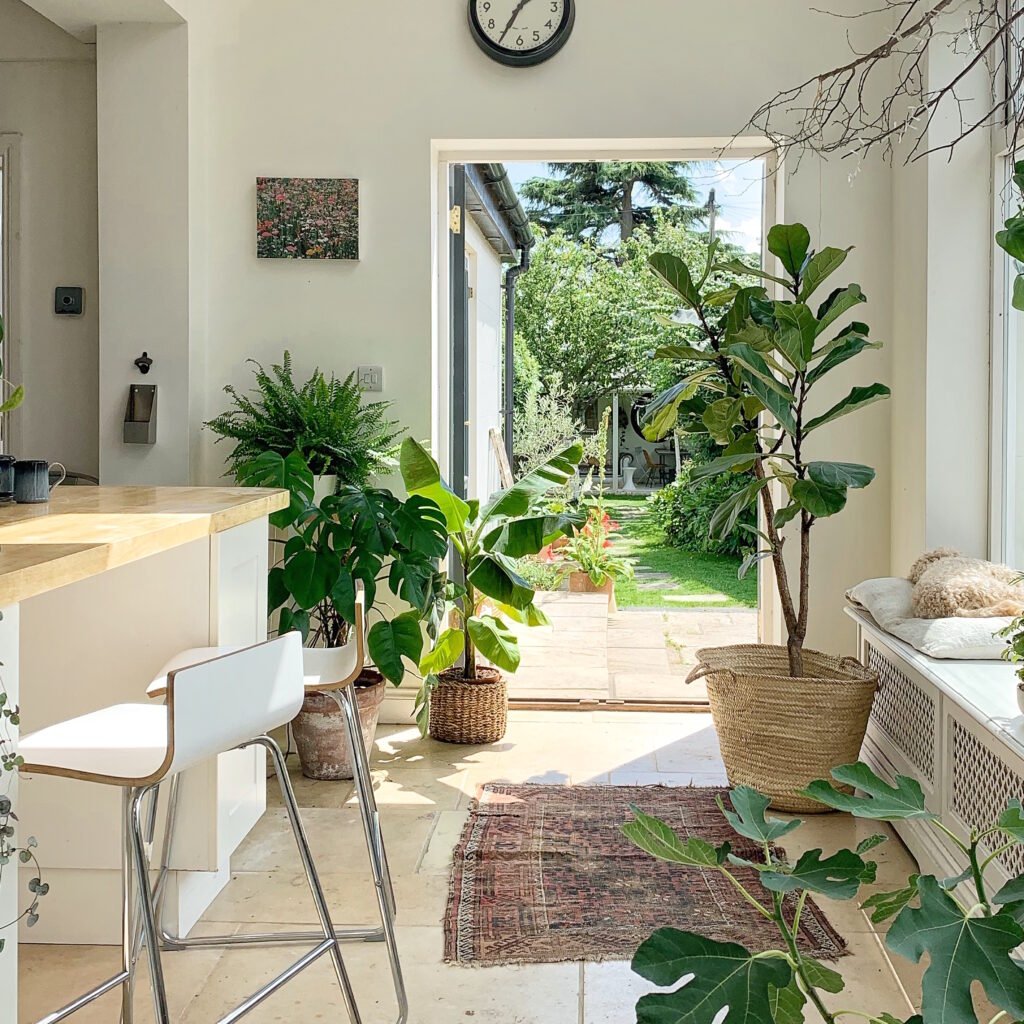
Creating a stunning indoor display with mixed leaf textures involves understanding contrast, proportion, and placement. You’re essentially designing a living composition, where each plant plays a distinct role.
1. Contrast Is Key
The magic happens when opposites meet. Pair plants with contrasting leaf surfaces for an eye-catching combination. For instance:
- Combine glossy-leaved plants like the ZZ Plant or Rubber Plant with matte-textured foliage such as Calathea Orbifolia or Fiddle Leaf Fig.
- Pair broad leaves with fine or narrow foliage. For example, the Monstera Deliciosa looks fantastic next to the Asparagus Fern.
The contrast draws attention and helps each plant stand out while maintaining overall balance.
2. Layering Textures
Layering plants of different heights and leaf textures creates a natural, cascading effect that mimics how plants grow in the wild. To do this effectively:
- Place larger, bold-textured plants as the focal point.
- Surround them with medium-textured varieties to bridge the transition.
- Add fine-textured plants at the base or edges to soften the display.
For instance, you can start with a large Monstera as your centerpiece, flank it with Philodendron Brasil for medium texture, and finish with Boston Ferns for delicate detailing.
3. Stick to a Color Palette
Even though texture is the focus, coordinating leaf colors is equally important. Mixing too many shades can make the display look chaotic. Choose a color scheme that harmonizes with your interior—such as all-green tones, green and variegated whites, or tropical greens with hints of burgundy.
A combination like Green ZZ Plant, Silver Satin Pothos, and Burgundy Rubber Plant creates balance and elegance through color and texture contrast.
Best Indoor Plants by Leaf Texture
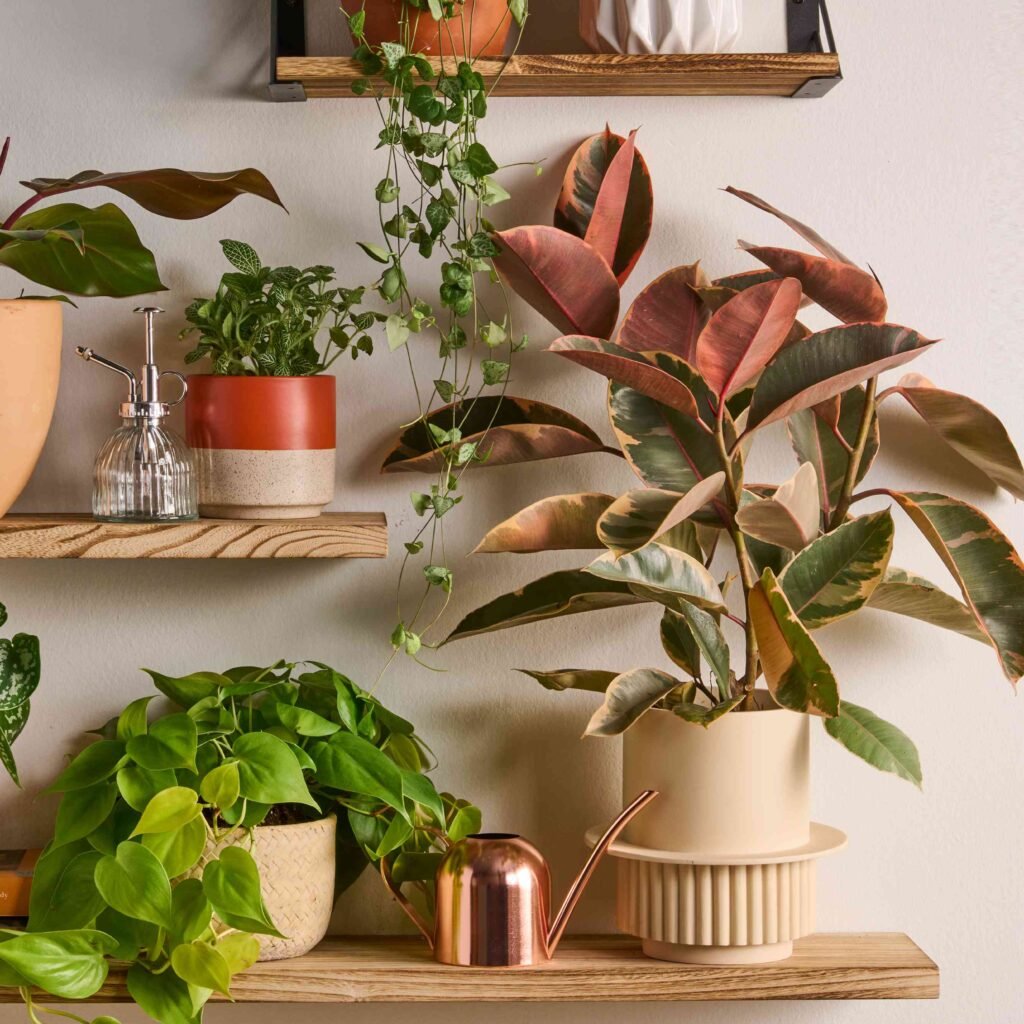
To help you design effectively, here’s a categorized list of indoor plants based on their leaf texture types.
1. Glossy-Textured Plants
- Rubber Plant (Ficus elastica) – Large, shiny leaves add drama and reflect ambient light.
- ZZ Plant (Zamioculcas zamiifolia) – Waxy foliage provides structure and low-maintenance elegance.
- Peace Lily (Spathiphyllum) – Glossy leaves paired with white blooms add sophistication.
- Philodendron Birkin – Glossy striped leaves give a modern touch.
2. Velvety-Textured Plants
- African Violet (Saintpaulia) – Soft, fuzzy leaves with vibrant flowers.
- Calathea Zebrina – Velvety, striped leaves add depth and visual luxury.
- Begonia Rex – Colorful, textured leaves with a metallic sheen.
- Tradescantia ‘Nanouk’ – Slightly hairy, pastel-toned leaves for a playful touch.
3. Rough or Leathery-Textured Plants
- Snake Plant (Sansevieria trifasciata) – Stiff, upright leaves for structure and contrast.
- Aloe Vera – Textured and slightly spiky leaves for a bold, architectural look.
- Succulents (Echeveria, Haworthia) – Thick, rough leaves that add substance and form.
- Aglaonema (Chinese Evergreen) – Broad, leathery leaves with patterned variegation.
4. Fine or Feathery-Textured Plants
- Asparagus Fern – Airy foliage that softens hard lines.
- Maidenhair Fern (Adiantum) – Delicate, lace-like leaves perfect for light contrast.
- Cypress Vine or Mimosa Pudica – Unique, finely divided leaves for visual movement.
- Baby’s Tears (Soleirolia soleirolii) – Tiny, cascading leaves for ground coverage.
Design Ideas for Mixing Leaf Textures Indoors
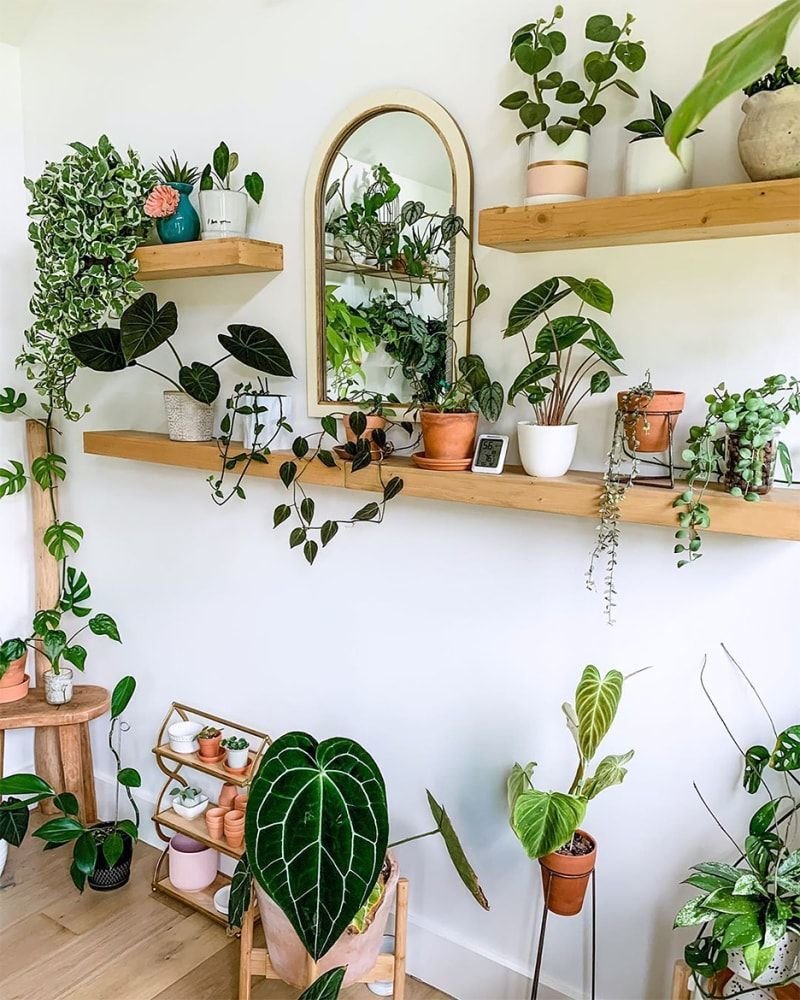
Here are a few creative display concepts that highlight the power of texture in indoor plant styling:
1. The Modern Minimalist Display
If your space has clean lines and neutral tones, choose a few plants with strong, simple textures.
- Use a Rubber Plant as your anchor, add a ZZ Plant for a second glossy layer, and finish with a Snake Plant for vertical texture contrast.
- Place them in sleek ceramic or metallic pots to maintain a minimalist aesthetic.
2. The Tropical Jungle Corner
For lush, layered charm, mix bold, velvety, and feathery foliage.
- Combine Monstera, Calathea Orbifolia, Boston Fern, and Philodendron Brasil.
- Use rattan or bamboo planters to enhance the tropical vibe and position plants at varying heights for a cascading effect.
3. The Bohemian Shelf Garden
A mix of small pots with diverse textures works wonders on open shelves.
- Try pairing Pothos, Spider Plant, Begonia Rex, and Tradescantia in contrasting containers.
- Hang a String of Hearts or English Ivy for trailing softness and dynamic movement.
4. The Office Green Zone
For a work-friendly environment, choose low-maintenance yet visually striking plants.
- Combine ZZ Plant, Snake Plant, Aglaonema, and Peace Lily.
- Their contrasting leaf textures and upright forms add energy without needing frequent care.
Lighting and Texture: The Hidden Connection
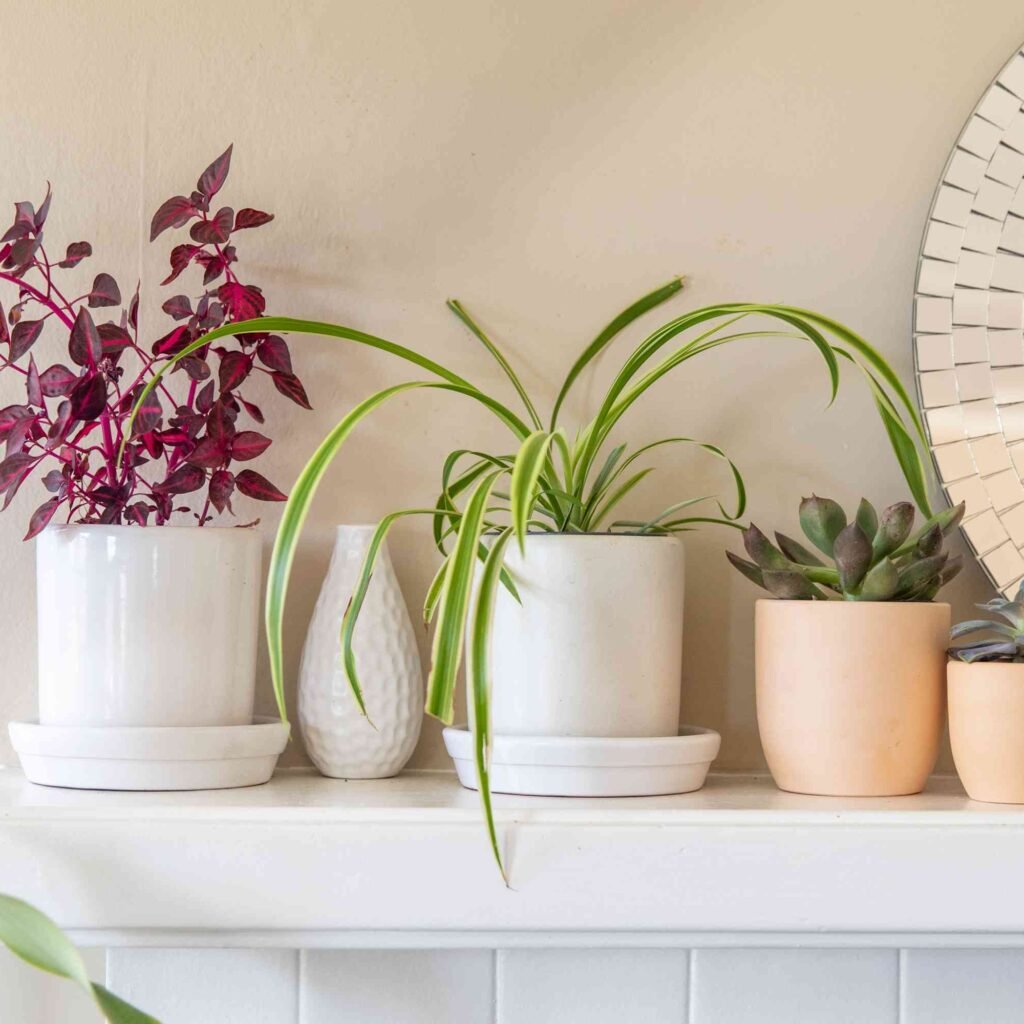
Light plays a key role in how textures appear. Glossy leaves shine beautifully under bright indirect light, emphasizing their reflective surfaces, while velvety or matte leaves look richer in lower light as they absorb rather than reflect light.
Tips:
- Place glossy-leaved plants near bright windows to enhance their glow.
- Keep fuzzy or delicate plants like African Violets away from harsh sunlight to prevent leaf scorch.
- Use artificial lighting to highlight mixed textures at night—LED grow lights with warm tones add dimension and ambiance.
Maintenance Tips for a Polished Look
To keep your textured display vibrant and healthy:
- Dust regularly. Smooth and glossy leaves collect dust easily, dulling their shine. Use a damp cloth or mild leaf shine spray.
- Prune strategically. Remove damaged or yellowing leaves to maintain contrast and structure.
- Rotate plants weekly. This ensures even light exposure, especially for displays featuring plants with different light preferences.
- Mist and humidify. Velvety and fine-textured plants like ferns and Calatheas thrive in humidity.
- Feed moderately. Use balanced liquid fertilizer every 4–6 weeks during the growing season for lush growth.
Final Thoughts
Mixing different leaf textures is more than just an aesthetic choice—it’s a form of living art. By understanding how light, texture, and form interact, you can transform your indoor garden into a visually rich and harmonious display that feels alive and balanced.
Whether you’re designing a sleek modern corner, a cozy bohemian nook, or a lush tropical sanctuary, the right combination of glossy, velvety, rough, and feathery leaves will make your space look stunning and full of life.
So, start experimenting—mix textures, play with heights, and watch your indoor display evolve into a breathtaking showcase of nature’s artistry.
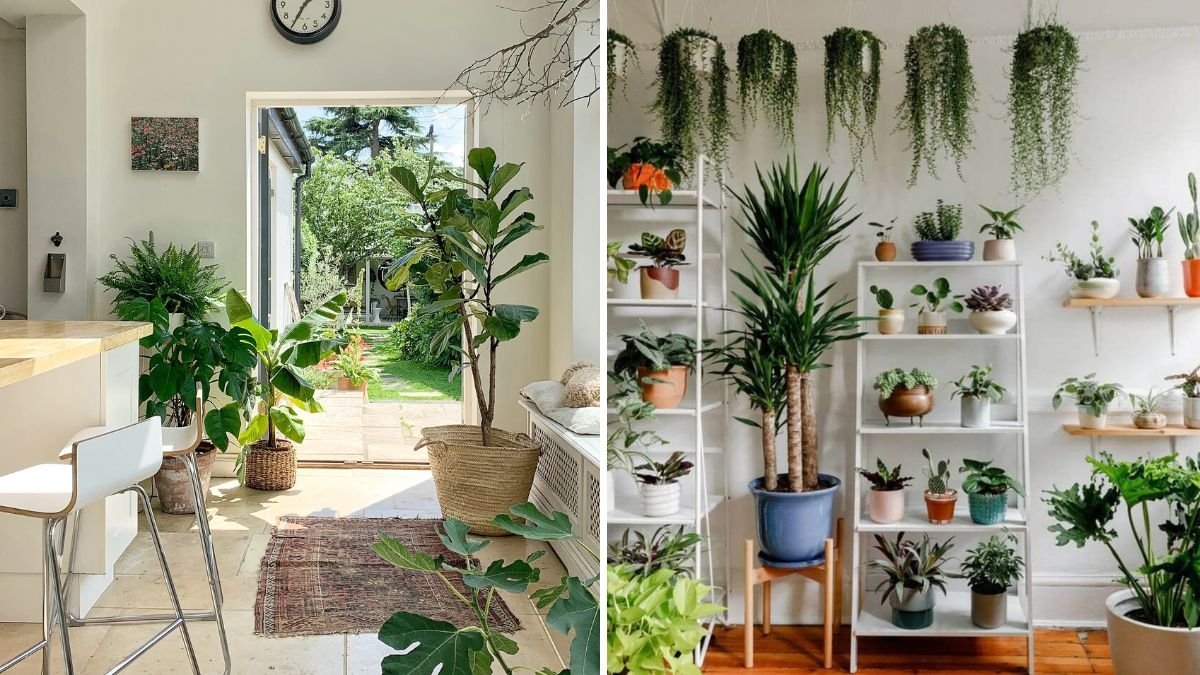




Leave A Comment